Did you know that purple lettuce, also known as red leaf lettuce, is not only a favorite among salad enthusiasts but also offers a myriad of health benefits? This vibrant and nutritious variety of leafy greens is gaining popularity for its rich color, unique flavor, and impressive nutrient profile.
Whether you’re a fan of leafy greens or looking to incorporate more nutritious vegetables into your diet, purple lettuce is a fantastic choice. Its deep purple hue makes for colorful salads and adds a touch of elegance to any dish. Not only is it visually appealing, but it also provides a wide range of health benefits that make it an excellent addition to your meals.
Red Leaf Lettuce Nutritional Profile
When it comes to nutrition, red leaf lettuce is a powerhouse. Despite being low in calories, this leafy green is packed with essential vitamins, minerals, and antioxidants.
Here is a breakdown of the nutrients you can find in three cups of shredded red leaf lettuce:
| Nutrient | Amount |
|---|---|
| Vitamin K | 288% of the Daily Value (DV) |
| Vitamin A | 288% of the DV |
| Magnesium | 12% of the DV |
| Manganese | 9% of the DV |
| Folate | 9% of the DV |
| Iron | 9% of the DV |
| Vitamin C | 8% of the DV |
| Potassium | 7% of the DV |
| Vitamin B6 | 7% of the DV |
| Thiamine | 6% of the DV |
| Riboflavin | 6% of the DV |
Red leaf lettuce has a similar nutritional profile to other popular leafy greens like romaine and green leaf lettuce. However, it stands out with its vibrant color and unique antioxidant content.
Speaking of antioxidants, red leaf lettuce is rich in beta carotene and anthocyanins, two powerful antioxidants that offer numerous health benefits. Beta carotene is converted into vitamin A in the body and supports eye health. Anthocyanins contribute to heart health and have anti-inflammatory properties.
With its impressive array of nutrients and antioxidants, red leaf lettuce is a fantastic addition to any diet. Whether you’re looking to boost your vitamin intake, support heart health, or incorporate more colorful vegetables into your meals, red leaf lettuce is a delicious and nutritious choice.
Hydration and Fullness with Red Leaf Lettuce
When it comes to staying hydrated, red leaf lettuce is your go-to option. With its high water content, this leafy green is a refreshing choice to quench your thirst and support optimal hydration levels. Incorporating red leaf lettuce into your meals not only keeps you hydrated but also helps control hunger and promotes a feeling of fullness.
Let’s dive deeper into how red leaf lettuce can be your hydrating and hunger-controlling ally. As you consume red leaf lettuce, its water-rich composition replenishes your body’s hydration needs, helping you stay refreshed throughout the day. This hydrating nature not only keeps your body functioning properly but also supports healthy skin, digestion, and overall well-being.
But that’s not all—red leaf lettuce also possesses thirst-quenching properties. Its juicy leaves offer a satisfying crunch and a burst of natural hydration, making it an excellent option to quell your thirst. By choosing red leaf lettuce as a hydrating snack or incorporating it into your meals, you can curb the urge to reach for sugary or calorie-laden beverages.
Besides its hydrating qualities, red leaf lettuce is beneficial for hunger control and promoting a feeling of fullness. The combination of its high water content and fiber contributes to satiety, helping you feel satisfied after enjoying a meal with red leaf lettuce. This can be particularly beneficial if you’re looking to manage your calorie intake or support weight loss efforts.
Ready to take advantage of the hydrating and hunger-controlling benefits of red leaf lettuce? Consider adding it to salads, wraps, or sandwiches for a crisp and refreshing touch. You can also use red leaf lettuce in smoothies to boost their nutritional content and make them even more thirst-quenching.
To visually showcase the impressive water content of red leaf lettuce, let’s take a look at the following table.
| Leafy Green | Water Content |
|---|---|
| Red Leaf Lettuce | 95% |
| Romaine Lettuce | 94% |
| Iceberg Lettuce | 96% |
As you can see, red leaf lettuce boasts an impressive water content of 95%, rivaling other popular lettuce varieties like romaine and iceberg. Its hydrating properties make it a top choice for refreshing and thirst-quenching meals.
Incorporating red leaf lettuce into your diet not only satisfies your thirst but also supports optimal hydration levels. So go ahead and indulge in this hydrating leafy green to stay refreshed and satisfied throughout the day.
Antioxidant Power of Red Leaf Lettuce
Red leaf lettuce is a nutritional powerhouse, packed with antioxidants that provide a wide range of health benefits. These antioxidants, including anthocyanins, beta carotene, and vitamin C, play a vital role in protecting the body from damage caused by harmful free radicals.
Anthocyanins, the pigments responsible for the vibrant red color of red leaf lettuce, have been linked to reduced inflammation and improved heart health. These powerful antioxidants neutralize free radicals and may help lower the risk of chronic diseases.
While anthocyanins stand out in red leaf lettuce, it also contains significant amounts of beta carotene and vitamin C, both essential for heart health. Beta carotene is converted into vitamin A in the body, which supports overall cardiovascular function and may help lower cholesterol levels. Vitamin C, on the other hand, can help reduce inflammation and protect against heart disease.
The antioxidant content in red leaf lettuce makes it a valuable addition to a heart-healthy diet. By incorporating this leafy green into your meals, you can reap the benefits of its antioxidant properties and support your overall well-being.
The Antioxidant Power of Red Leaf Lettuce
To further emphasize the antioxidant power of red leaf lettuce, let’s take a closer look at its key antioxidants:
| Antioxidant | Benefits |
|---|---|
| Anthocyanins | – Reduce inflammation – Improve heart health |
| Beta carotene | – Support heart health – Lower cholesterol levels |
| Vitamin C | – Reduce inflammation – Protect against heart disease |
“The antioxidant power of red leaf lettuce helps protect the body from damage caused by free radicals, while promoting heart health and reducing inflammation.”
– Nutritional Scientist, Dr. Emily Johnson
Incorporating red leaf lettuce into your diet is a flavorful way to boost your antioxidant intake and support a healthy heart. Whether enjoyed in salads, sandwiches, or wraps, this versatile leafy green can be a delicious addition to your meals.
Supporting Heart Health with Red Leaf Lettuce
When it comes to heart health, red leaf lettuce has impressive nutritional benefits that can help maintain a healthy cardiovascular system. This vibrant leafy green is packed with essential nutrients like magnesium and potassium, which play a crucial role in supporting heart function and reducing the risk of cardiovascular diseases.
Magnesium is important for regulating blood pressure and maintaining a steady heartbeat. Adequate consumption of magnesium has been linked to a lower risk of high blood pressure and heart failure. Potassium, on the other hand, helps relax the heart’s muscle cells and ensures a healthy heartbeat. A sufficient intake of potassium is associated with a reduced risk of heart diseases.
By adding red leaf lettuce to your diet, you can provide your body with these heart-healthy nutrients. Whether enjoyed in salads, sandwiches, or smoothies, red leaf lettuce offers a delicious and nutritious way to support your cardiovascular health.
| Benefit | Role | Food Source |
|---|---|---|
| Magnesium | Regulates blood pressure Supports a steady heartbeat |
Red leaf lettuce Spinach Avocado |
| Potassium | Relaxes heart muscle cells Maintains a healthy heartbeat |
Red leaf lettuce Bananas Oranges |
Including red leaf lettuce in your meals can be a simple and enjoyable way to prioritize your heart health. So, why not add this nutritious green to your next salad or wrap?
Enhancing Eye Health with Red Leaf Lettuce
When it comes to maintaining optimal eye health, incorporating red leaf lettuce into your diet can be a game-changer. This vibrant leafy green is rich in vitamin A, particularly in the form of beta carotene, which is essential for supporting vision and overall eye health.
Vitamin A plays a crucial role in the functioning of the retina, the thin layer of tissue at the back of the eye responsible for converting light into electrical signals that our brain interprets as images. A deficiency in vitamin A can lead to night blindness, where it becomes difficult to see in low light conditions, and even more severe conditions like age-related macular degeneration (AMD).
Adequate intake of vitamin A from sources like red leaf lettuce can help prevent these vision-related issues and support long-term eye health. Beta carotene, the main form of vitamin A found in red leaf lettuce, is converted by the body into the active form of vitamin A that the eyes can use.
By regularly including red leaf lettuce in your diet, you can ensure you’re providing your eyes with the necessary nutrients to maintain clear vision and prevent the onset of conditions like macular degeneration, which can lead to gradual vision loss over time.
So make sure to add red leaf lettuce to your meals, whether in salads, sandwiches, or wraps, and give your eyes the support they need to stay healthy and vibrant.
The Power of Vitamin A and Beta Carotene
The key component that makes red leaf lettuce a superstar for eye health is its high content of vitamin A, primarily in the form of beta carotene. Beta carotene is a plant pigment responsible for the rich red color of the lettuce leaves.
When consumed, the body converts beta carotene into vitamin A, which is then used by the eyes to maintain vision and support various eye functions. Vitamin A is vital for the proper functioning of the cornea, the transparent outer layer of the eye, as well as for the production of the visual pigment rhodopsin, which enables us to see in low-light conditions.
Additionally, beta carotene, being a powerful antioxidant, helps protect the eyes from damage caused by harmful free radicals. Free radicals can lead to oxidative stress and inflammation, which are risk factors for various eye diseases, including macular degeneration.
By incorporating red leaf lettuce, rich in vitamin A and beta carotene, into your diet, you can nourish your eyes and provide them with the essential nutrients and antioxidants they need to thrive.
Reducing the Risk of Cancer with Red Leaf Lettuce
The antioxidants found in red leaf lettuce, such as beta carotene, anthocyanins, and vitamin C, have been linked to a reduced risk of certain types of cancer. These antioxidants help protect cells from damage caused by free radicals, which can lead to the development of cancer. Including red leaf lettuce in your diet may contribute to overall cancer prevention.
Research has indicated that the antioxidants in red leaf lettuce play a crucial role in inhibiting the growth of cancer cells and reducing the risk of various types of cancer. The high levels of beta carotene in red leaf lettuce have been associated with a lower risk of lung cancer, while anthocyanins, the vibrant red pigments in the leaves, have shown potential in preventing colon and breast cancers.
Furthermore, vitamin C, another powerful antioxidant present in red leaf lettuce, helps strengthen the immune system and aids in the body’s natural defense against cancerous cells. Vitamin C can neutralize harmful free radicals, reducing the risk of cellular damage and DNA mutations that can lead to the development of cancer.
“Including red leaf lettuce in your diet is a simple and enjoyable way to incorporate cancer-fighting antioxidants into your meals. Its delicious flavor and vibrant color make it a versatile addition to salads, sandwiches, and wraps.”
Additionally, red leaf lettuce is a nutrient-rich vegetable that provides vitamins, minerals, and dietary fiber that are essential for overall health and well-being. By including red leaf lettuce in your diet, you not only benefit from its cancer-preventing properties but also support your overall nutritional intake.
Antioxidant Content Comparison
| Antioxidant | Beta Carotene (mg per 100g) | Anthocyanins (mg per 100g) | Vitamin C (mg per 100g) |
|---|---|---|---|
| Red Leaf Lettuce | 1.2 | 19.7 | 13.2 |
| Romaine Lettuce | 0.1 | 0 | 2.8 |
| Spinach | 0.6 | 2.1 | 28.1 |
This comparison table showcases the antioxidant content of red leaf lettuce, romaine lettuce, and spinach. As evident from the data, red leaf lettuce stands out as a rich source of beta carotene, anthocyanins, and vitamin C, making it an excellent choice for cancer prevention.
Including red leaf lettuce in your meals not only adds a delightful crunch and vibrant color but also provides you with a nutritious and cancer-fighting boost. Experiment with creative recipes and combinations to enjoy the full benefits of this health-enhancing leafy green.
Weight Loss Support from Red Leaf Lettuce
When it comes to achieving your weight loss goals, incorporating red leaf lettuce into your diet can be a game-changer. Not only is it delicious and versatile, but it also offers several benefits that can support your weight loss journey.
First and foremost, red leaf lettuce is low in calories. A three-cup serving of shredded red leaf lettuce contains only about 20 calories. This means you can enjoy a generous portion without consuming excessive calories, making it an excellent choice for those looking to shed pounds.
Additionally, red leaf lettuce has a high water content. Water-rich foods are known for their ability to promote weight loss by helping you feel full and satisfied. By adding red leaf lettuce to your meals, you can increase your water intake and keep hunger at bay.
Furthermore, red leaf lettuce is a fantastic source of fiber. Fiber aids in digestion and can contribute to weight loss efforts. It helps regulate your appetite, prolongs feelings of fullness, and promotes healthy bowel movements. By incorporating red leaf lettuce into your diet, you can increase your fiber intake and support your weight loss goals.
Make the most of red leaf lettuce’s weight loss benefits by including it in a variety of dishes. Whether you use it as a base for salads, a filling for sandwiches or wraps, or a nutritious addition to smoothies, red leaf lettuce is incredibly versatile.
“Red leaf lettuce is a low-calorie, high-water-content, and fiber-rich addition to any weight loss diet. It’s a satisfying and nutritious choice that can help you achieve your weight loss goals.”
To summarize, red leaf lettuce is an excellent ally in your weight loss journey. Its low calorie, high water content, and fiber-rich nature make it a satisfying and nutritious choice. By incorporating red leaf lettuce into your meals, you can support your weight loss efforts and work towards achieving a healthy weight.
Easy and Versatile Ways to Enjoy Red Leaf Lettuce
When it comes to red leaf lettuce, the possibilities are endless. This incredibly versatile vegetable can be enjoyed in various ways, adding flavor, crunch, and vibrant color to your meals. Whether you’re looking for a refreshing salad, a satisfying sandwich, a flavorful wrap, or a nutritious smoothie, red leaf lettuce has got you covered. Let me share with you some easy and delicious recipe ideas that will elevate your culinary experience.
1. Vibrant Salad Creations
Red leaf lettuce makes a perfect base or garnish for your salads. Its crisp texture and beautiful hues will enhance any salad creation. Whether you’re creating a simple garden salad or a gourmet masterpiece, red leaf lettuce adds a fresh and vibrant element. Combine it with other colorful vegetables, fruits, nuts, and dressings of your choice for a delightful salad bursting with flavor.
2. Scrumptious Sandwiches and Wraps
Upgrade your sandwiches and wraps by using red leaf lettuce leaves as a substitute for traditional lettuce. The large, sturdy leaves provide a crisp and refreshing bite, elevating both the taste and appearance of your favorite handheld meals. Wrap your favorite fillings in a red leaf lettuce leaf and enjoy the added crunch and freshness that it brings.
3. Refreshing and Nutritious Smoothies
Yes, you read that right – red leaf lettuce can be a secret ingredient in your smoothies! Blend a handful of red leaf lettuce with your choice of fruits, yogurt, and other favorite smoothie ingredients for a nutritious and refreshing boost. The mild flavor of red leaf lettuce blends seamlessly, contributing to the overall healthiness of your smoothie without overpowering the other flavors.
I love experimenting with different smoothie combinations, and adding red leaf lettuce has been a game-changer. It adds a subtle earthiness and an extra boost of nutrients to my favorite smoothie recipes.
With red leaf lettuce, there are endless opportunities to get creative in the kitchen. Try incorporating it into your favorite dishes, explore new flavors, and let your imagination run wild. The versatility of red leaf lettuce makes it a must-have ingredient for any health-conscious food enthusiast.
Growing Red Leaf Lettuce in Your Vegetable Garden
Growing red leaf lettuce in your vegetable garden is a rewarding and sustainable practice. It allows you to enjoy organic produce and have control over the cultivation process.
To start your lettuce plants on the right foot, choose organic seeds or seedlings. This ensures a chemical-free start and aligns with your commitment to growing homegrown and healthy vegetables.
Implementing eco-friendly gardening practices is key to successful red leaf lettuce cultivation. This includes efficient watering techniques, companion planting, and crop rotation. By being mindful of these cultivation practices, you can promote healthy growth and protect your lettuce from pests and diseases.
Watering Techniques
To optimize water usage and minimize waste, consider utilizing techniques such as drip irrigation or soaker hoses. These methods deliver water directly to the plant roots, reducing evaporation and ensuring efficient hydration.
Companion Planting
Pairing red leaf lettuce with compatible companion plants can benefit their growth. For example, planting lettuce near herbs like dill or chamomile can attract beneficial insects that help control pests naturally.
Crop Rotation
Rotate your lettuce crops each season to prevent the buildup of pests and diseases in the soil. Avoid planting lettuce in the same spot for consecutive years to maintain soil health and reduce the likelihood of plant-specific issues.
“Growing red leaf lettuce in my vegetable garden has not only provided me with sustainable and homegrown produce but also a sense of fulfillment and connection to nature.”
– Lisa Thompson, avid vegetable gardener
| Cultivation Practice | Benefits |
|---|---|
| Choosing organic seeds or seedlings | Chemical-free start for plants |
| Implementing efficient watering techniques | Optimized water usage and reduced waste |
| Practicing companion planting | Natural pest control and enhanced growth |
| Utilizing crop rotation | Prevention of pests and diseases buildup in soil |
By following these cultivation practices, you can ensure the success of your red leaf lettuce and enjoy the nutritious rewards of your labor.
Historical and Botanical Significance of Red Leaf Lettuce
Red leaf lettuce, also known as red leaf salad or red romaine, carries a captivating historical significance that dates back to ancient Egypt. Cultivated and savored by the Egyptians, red leaf lettuce held a special place in their culture as a symbol of fertility and love. This leafy green played a prominent role in their culinary traditions, as well as their religious and medicinal practices.
Botanically speaking, red leaf lettuce belongs to the Asteraceae family, which encompasses a diverse range of plants. This botanical family is home to various other well-known and beloved species, including artichokes, sunflowers, daisies, and chrysanthemums. The Asteraceae family showcases the stunning diversity and resilience of nature, with each plant boasting unique characteristics and contributions to the world of botany.
The Ancient Egyptians and Red Leaf Lettuce
Red leaf lettuce was highly regarded by the ancient Egyptians, who believed it had mystical properties associated with fertility and love. It played a significant role in their religious rituals and was even used to adorn tombs and burial sites as a symbolic representation of rebirth and eternal life.
It is fascinating to consider the historical context and cultural significance of red leaf lettuce as we appreciate its remarkable journey through time. By exploring the deep roots that this leafy green holds in ancient Egypt and recognizing its place within the Asteraceae family, we gain a deeper appreciation for the bountiful wonders of nature and the extraordinary heritage of our favorite salad ingredient.
Conclusion
In conclusion, purple lettuce, also known as red leaf lettuce, is a versatile and nutritious vegetable with a range of health benefits. Incorporating purple lettuce into your diet can promote heart health, enhance eye health, and help reduce the risk of cancer. Its low calorie content and high water content make it an excellent choice for weight loss efforts. Purple lettuce can be enjoyed in a variety of dishes, such as salads, sandwiches, wraps, and smoothies, adding both flavor and visual appeal to your meals.
Growing purple lettuce in your vegetable garden is a rewarding and sustainable practice. You can enjoy the benefits of organic produce while having control over the cultivation process. By implementing eco-friendly gardening practices, you can ensure the health and vitality of your purple lettuce plants. Vegetable gardening provides an opportunity to connect with nature, save money, and embrace a healthier lifestyle.
So why not start incorporating purple lettuce into your diet and exploring the joys of vegetable gardening? With its distinct color, delicious taste, and array of health benefits, purple lettuce is a nutritious addition to any meal. Whether you’re a seasoned gardener or a first-time grower, purple lettuce is a great vegetable to cultivate in your own backyard. Embrace the beauty and goodness of purple lettuce and enjoy the many health benefits it has to offer.

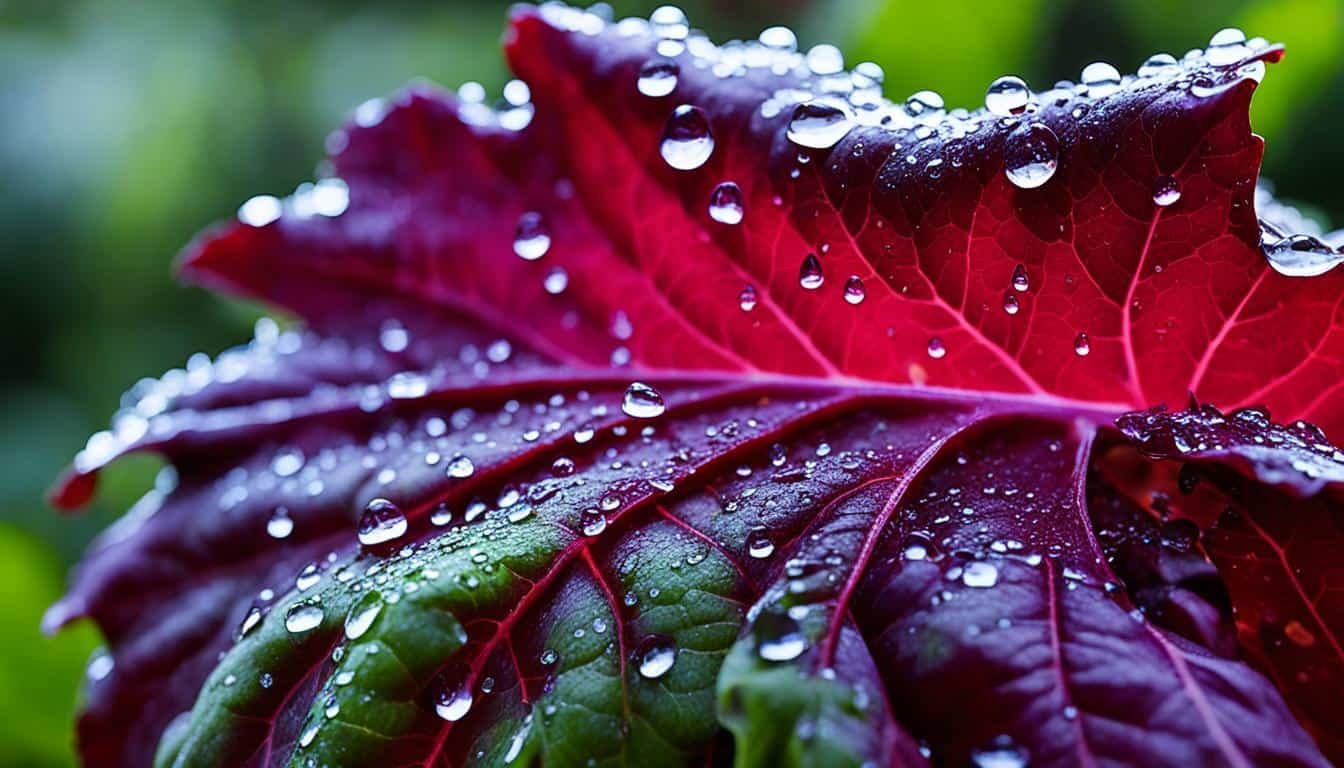

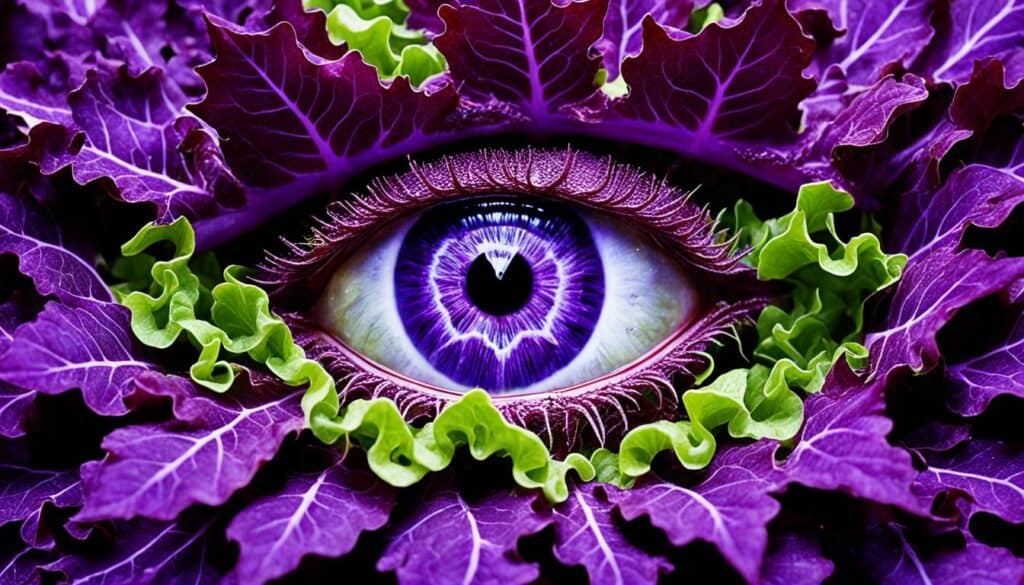
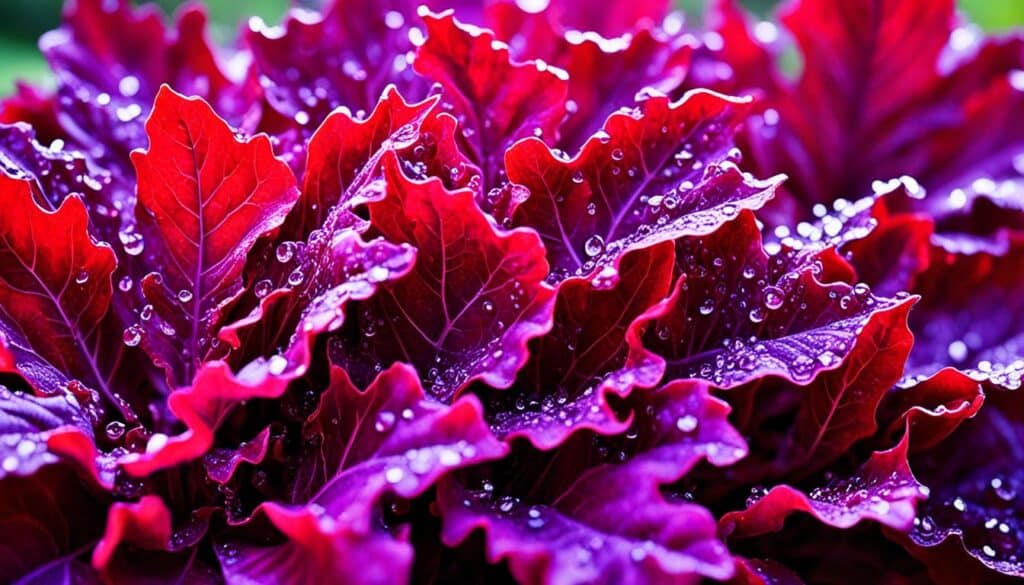
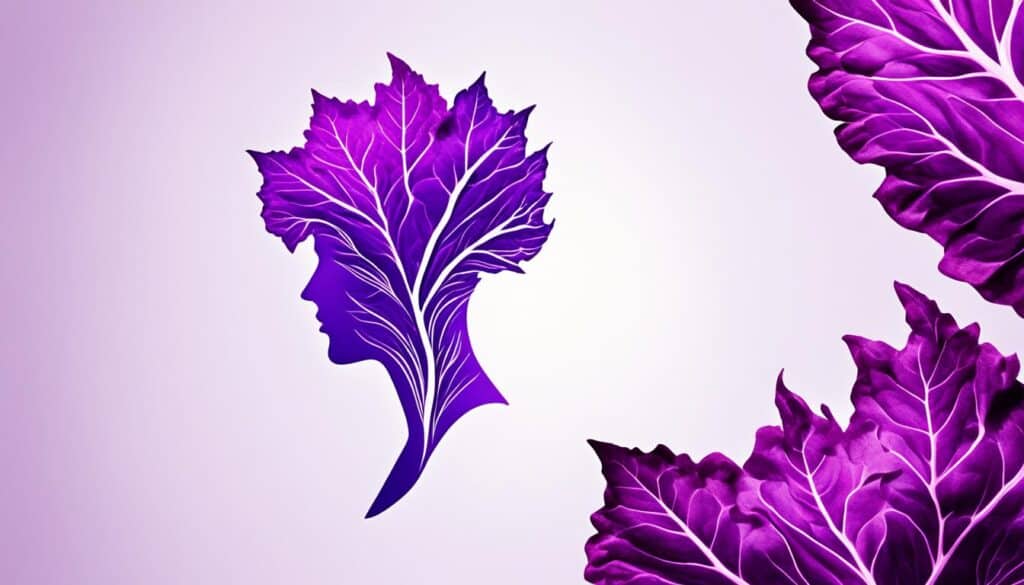
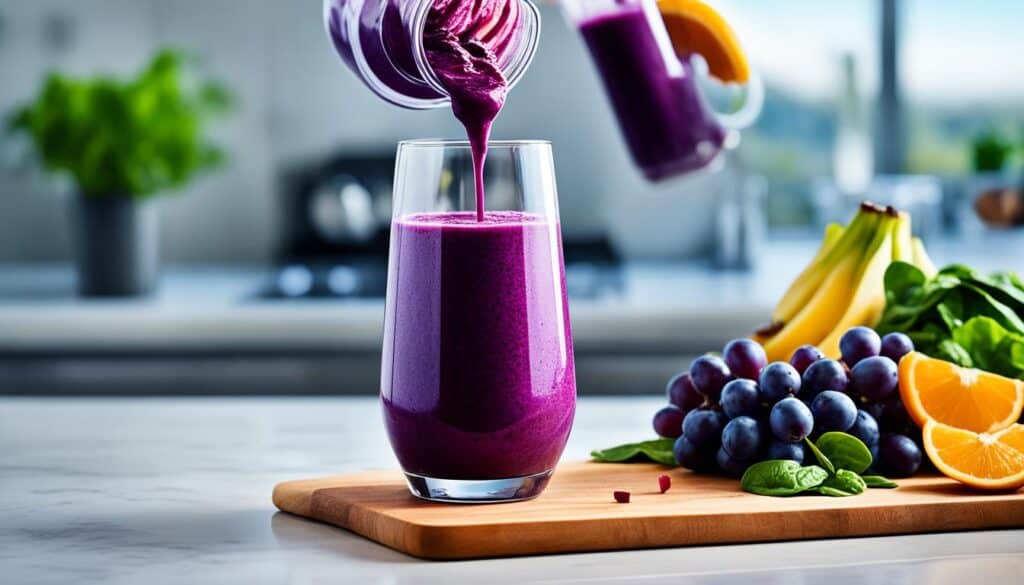



Leave a Reply